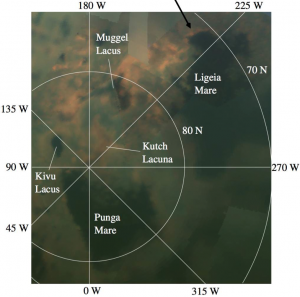
A false-color, infrared map of Titan’s north pole. The black arrow points to an evaporite deposit along the shore of Ligeia Mare.
I read a recent paper by MacKenzie et al. (2014) about evaporite deposits along the rims of lakes on Saturn’s moon Titan.
The more we learn about Saturn’s enigmatic moon Titan, the more it resembles the Earth: Titan has a thick atmosphere made mostly of nitrogen and a complex “hydrologic” cycle involving big storms, river beds, and even lakes and seas. But, because Titan’s surface temperatures are nearly -300 degrees F, unlike on Earth, the liquids involved in the cycle are methane and ethane.
And recently, observations from the Cassini spacecraft in orbit around Saturn have found evidence for what may be evaporite deposits along the rims of many of Titan’s seas and lakes. Evaporite deposits typically form on Earth when water collects in isolated basins and slowly evaporates away, leaving behind the minerals dissolved in the water. They are common throughout the Southwest in the US.
In this recent paper, MacKenzie and colleagues conducted a thorough mapping of the putative evaporite deposits on Titan to understand their extent and possible connections to climate. The study presents lots of interesting results: in particular, they find evaporites occur at a variety of latitudes, including in places that look a lot like dry lake beds. This result corroborates the suggestion that these places were indeed filled with liquid in the past but climatic changes have since dried them out.
Surprisingly, even though there are many apparent dry lake beds near the south pole on Titan, MacKenzie and colleagues find no evidence for evaporites there. They speculate either the deposits were laid down long ago (> 50,000 years ago) and have since been buried OR conditions were never suitable for evaporite formation, even when the south polar lake beds were filled. Either result could be telling us something very interesting about evolution of Titan’s climate.